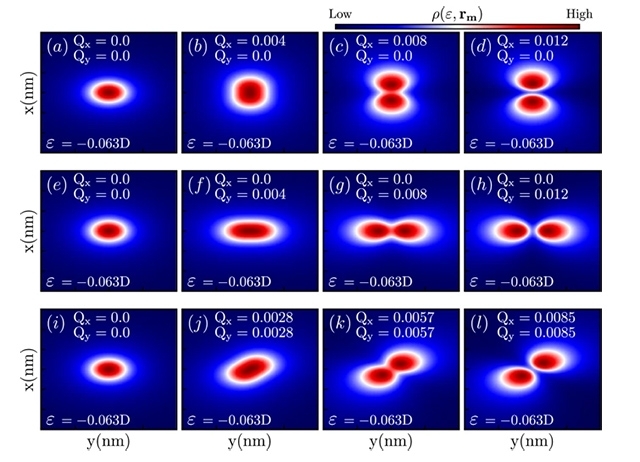

Theoretical findings in a study performed by researchers with FAPESP’s support and published in Scientific Reports could be exploited in the development of quantum computing (images show densities in systems studied / Scientific Reports)
Theoretical findings in a study performed by researchers with FAPESP’s support and published in Scientific Reports could be exploited in the development of quantum computing.
Theoretical findings in a study performed by researchers with FAPESP’s support and published in Scientific Reports could be exploited in the development of quantum computing.

Theoretical findings in a study performed by researchers with FAPESP’s support and published in Scientific Reports could be exploited in the development of quantum computing (images show densities in systems studied / Scientific Reports)
By José Tadeu Arantes | Agência FAPESP – In a study published in Scientific Reports, a group of researchers affiliated with São Paulo State University (UNESP) in Brazil describes an important theoretical finding that may contribute to the development of quantum computing and spintronics (spin electronics), an emerging technology that uses electron spin or angular momentum rather than electron charge to build faster, more efficient devices.
The study was supported by FAPESP. Its principal investigator was Antonio Carlos Seridonio, a professor in UNESP’s Department of Physics and Chemistry at Ilha Solteira, São Paulo State. His graduate students Yuri Marques, Willian Mizobata and Renan Oliveira also participated.
The researchers observed that molecules with the capacity to encode information are produced in systems called Weyl semimetals when time-reversal symmetry is broken.
These systems can be considered three-dimensional versions of graphene and are associated with very peculiar kinds of objects called Weyl fermions. These are massless, quasi-relativistic, chiral particles – quasi-relativistic because they move similarly to photons (the fundamental “particles” of light) and behave as if they were relativistic, contracting space and dilating time.
The term “chiral” applies to an object that cannot be superimposed onto its mirror image. A sphere is achiral, but our left and right hands are chiral. In the case of Weyl fermions, chirality makes them behave as magnetic monopoles, unlike all magnetic objects in the trivial world, which behave as dipoles.
Weyl fermions were proposed in 1929 by German mathematician, physicist and philosopher Hermann Weyl (1885-1955) as a possible solution to Dirac’s equation. Formulated by British theoretical physicist Paul Dirac (1902-1984), this equation combines principles of quantum mechanics and special relativity to describe the behavior of electrons, quarks and other objects.
Weyl fermions are hypothetical entities and have never been observed freely in nature, but studies performed in 2015 showed that they can be the basis for explaining certain phenomena.
Similar to Majorana fermions, which also solve Dirac’s equation, Weyl fermions manifest themselves as quasi-particles in condensed matter molecular systems.
This field, in which high-energy physics and condensed matter physics converge, has mobilized major research efforts, not only because of the opportunities it offers for the development of basic science but also because the peculiarities of these quasi-particles may one day be used in quantum computing to encode information.
The new study conducted at UNESP Ilha Solteira advanced in that direction. “Our theoretical study focused on molecules made up of widely separated atoms. These molecules wouldn’t be viable outside the Weyl context because the distance between atoms prevents them from forming covalent bonds and hence from sharing electrons. We demonstrated that the chirality of electron scattering in Weyl semimetals leads to the formation of magnetic chemical bonds,” Seridonio told Agência FAPESP.
Examples of Weyl semimetals include tantalum arsenide (TaAs), niobium arsenide (NbAs) and tantalum phosphide (TaP).
“In these materials, Weyl fermions play an analogous role to that of electrons in graphene. However, graphene is a quasi-2D system, whereas these materials are fully 3D,” Seridonio said.
The theoretical study showed that Weyl fermions in these systems appear as splits in Dirac fermions, a category comprising all material particles of the so-called Standard Model, with the possible exception of neutrinos.
These splits occur at points where the conduction band (the space in which free electrons circulate) touches the valence band (the outermost layer of electrons in atoms).
“A break in symmetry makes this point, the Dirac node, split into a pair of Weyl nodes with opposite chiralities. In our study, we broke the time-reversal symmetry,” Seridonio said.
Time reversal symmetry essentially means that a system remains the same if the flow of time is reversed. “When this symmetry is broken, the resulting molecule has spin-polarized orbitals.”
In usual molecular systems, spin-up electrons and spin-down electrons are evenly distributed in the electron cloud. This is not the case in Weyl systems.
“The result is a molecule in which the spin-up and spin-down electron clouds are spatially different. This peculiarity can be used to encode information because the molecule can be associated with the binary system, which is the bit or basic unit of information,” Seridonio said.
The article titled “Chiral magnetic chemical bonds in molecular states of impurities in Weyl semimetals” (doi: https://doi.org/10.1038/s41598-019-44842-8) by Y. Marques, W. N. Mizobata, R. S. Oliveira, M. de Souza, M. S. Figueira, I. A. Shelykh and A. C. Seridonio can be read at www.nature.com/articles/s41598-019-44842-8.
Republish
The Agency FAPESP licenses news via Creative Commons (CC-BY-NC-ND) so that they can be republished free of charge and in a simple way by other digital or printed vehicles. Agência FAPESP must be credited as the source of the content being republished and the name of the reporter (if any) must be attributed. Using the HMTL button below allows compliance with these rules, detailed in Digital Republishing Policy FAPESP.





